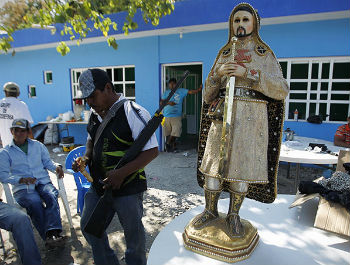A new collection of essays tackles patterns of cultish behavior and ritualized violence among illegal groups across the globe, from the Zetas and the Familia Michoacana to Al Qaeda and the Lord’s Resistance Army.
Edited by longtime organized crime analyst Robert Bunker, Blood Sacrifices: Violent Non-State Actors and Dark Magico-Religious Activities consists of 14 essays by 13 different authors, spread across nearly 300 pages. The tie linking the writings is revealed in the title; all of the pieces relate to different criminal groups’ use of blood sacrifice, ritualized violence, pseudo-religious bloodshed, or some offshoot thereof.
Beyond that, the essays’ focus varies a great deal. In addition to the groups mentioned above, readers are treated to extended treatises on Las Reglas de Kongo (an Afro-Cuban religious tradition that has gained popularity among certain traffickers); amphetamine and other drug use by members of illicit groups; and human sacrifice among Islamic terrorist organizations.
Bunker’s essay, titled “Narcocultura and Spirituality: Narco Saints, Santa Muerte, and Other Entities,” is easily the richest material for students of Latin American organized crime. Focusing primarily on Mexico, Bunker details the manifestations of countercultural religiosity among Mexican criminal groups, from Jesús Valderde and Santa Muerte to more obscure variants like San Simón and Juan Soldado. He describes their influence over criminal groups that dominate the nation, including the Zetas, the Knights Templar, and the Sinaloa Cartel. His essay also includes a lengthy section on La Familia founder Nazario Moreno González, an evangelical Christian whose devotion to the New Jerusalem had a substantial impact on the way his gang presented itself to the public.
SEE ALSO: Familia Michoacana News and Profile
Bunker’s essay offers as comprehensive an overview of Mexican gangs’ predilections for cult behaviors, pseudo-religious rituals, and the titular blood sacrifice as has been published to date. He presents the phenomenon as something akin to a parallel religious culture that has emerged in opposition to the orthodox Catholicism that has dominated in Mexico since its foundation. Taken in tandem with the rest of the book, Bunker’s essay points to many similarities between the Mexican groups’ affinity for ritualized bloodshed and those of other organizations around the world.
InSight Crime Analysis
Apparently nodding toward the incongruity of seriously studying blood sacrifices in 2016, Bunker and his co-authors compare their approach with alternative frameworks pursued by contemporary analysts, ranging from behavior science and rational scientific inquiry to data mining. They also argue, both explicitly and implicitly, that this salacious, bloodthirsty aspect of criminal groups has not received its due attention.
To a large degree, they make a compelling case. It becomes clear over the course of the book that the cases of cartels’ brutality are more widespread than is often appreciated; the oft-cited tally of total gangland deaths in Mexico since 2006, currently above 100,000, has become shorthand for a destructive pattern, but it fails to convey the acts of wanton cruelty and suffering that populate this narrative. The focus on blood sacrifice fills that void.
Bunker and company demonstrate that such cases are often linked to rituals or abetted by cultish belief systems, rather than being entirely calculated and tactical. In other words, gangs may resort to atrocities for propaganda, but this propaganda function has periodically stemmed from the gangs’ ritualization of violence. Because the atrocities have such a devastating impact on public opinion, this ritualized bloodshed has a genuine though indirect impact on the security strategies Mexico and other nations have adopted.
SEE ALSO: InDepth Coverage of NarcoCulture
For instance, Felipe Calderón came to the presidency in 2006 intent on launching a war against organized crime following a drumbeat of spectacular attacks during the campaign, most famously when members of the Familia Michoacana dumped several severed heads around a nightclub in Uruapan. While it is unclear that this event was part of any larger ritual, the Familia was one of the first gangs to endow its activities with a veneer of dark religiosity, and it subsequently became known for such atrocities.
In this case, the line from the emergence of a gang steeped in the occult to a massive change in Mexico’s policies was short indeed. As the Familia shows, we discount the impact of such criminal practices at our peril.
The book is less convincing insofar as it serves as an argument that Latin American gangs’ propensity for blood sacrifice should be at the forefront of our collective understanding of their operations, or that it should be influencing policymakers in developing public security strategies. Ultimately, there is not much evidence that trafficking groups’ atrocities are much more than a byproduct of their members’ existence on the margins of society and years of relentless combat, rather than a strategic objective in and of itself. While projecting rational incentives onto criminal groups carries with it certain risks, treating them as profit-motivated and power-hungry is a better guide to Latin American criminal gangs’ goals and their dangers than any alternative.
“Blood Sacrifice” also overindulges the idea that this counterculture is invading Mexican society writ large. One essay puts forward the notion that “traditional Mexican values and norms are being incrementally replaced by those steeped in illicit drug use, criminality, and violence.” There is no easy way to measure this, but for people who spend substantial time among Mexican civil society, this implication that occult rituals are gaining a substantial toehold simply doesn’t ring true. The Mexicans who were horrified by corruption and brutality in 2006 generally remain so today. The values that define the society may have been tested by a decade of public security challenges, but they remain largely unchanged.

